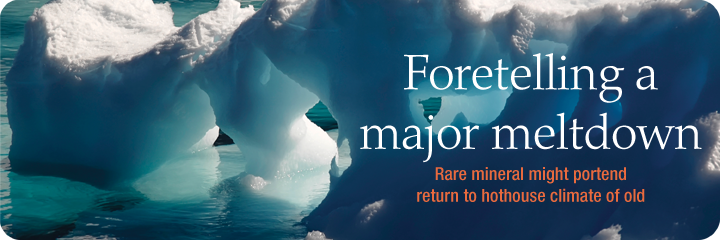
By discovering the meaning of a rare mineral that can be used to track ancient climates, geologist Tim Lowenstein is helping climatologists and others better understand what we’re probably in for over the next century or two as global warming begins to crank up the heat — and, ultimately, to change life as we know it the world over.
“I think the Earth will be a very different place in the next hundred years or so, and that many species will adapt to it and many won’t,” Lowenstein said. “Humans are supremely good at adapting. But, rich countries will adapt much better than poor countries and other species will have far more trouble coping with environmental change. There are going to be challenges we can’t even imagine right now.”
Lowenstein’s concerns are rooted not in unfounded speculation about unprecedented future happenings, but in the scientific discovery and analysis of mineral samples formed during the Eocene Epoch, the warmest period on Earth in the last 65 million years.
What Lowenstein and his colleague Robert Demicco at Binghamton University have discovered is that nahcolite, a rare, yellowish-green or brown carbonate mineral, only forms on Earth under environmental conditions marked by very high atmospheric CO2 levels. That establishes it as both a marker and a benchmark that can be used by scientists as they consider the likely climatic implications of ever-increasing CO2 levels in our atmosphere today.
More specifically, nahcolite suggests that Eocene warming was concurrent with atmospheric CO2 levels of at least 1,125 parts per million (ppm), which is 3 times the current levels of 380 ppm, but not all that much higher than we can expect on Earth in the next 100 years or so given generally accepted scientific projections based on fossil-fuel consumption.

Lowenstein and Demicco first reported their findings in a 2006 Science article titled “Elevated Eocene Atmospheric CO2 and Its Subsequent Decline.” They concluded that estimates of ancient atmospheric CO2 can be determined from sodium carbonate minerals precipitated from water in contact with the atmosphere.
At present CO2 levels of around 380 ppm, the sodium carbonate mineral trona crystallizes at temperatures of around 25 degrees Celsius (77 degrees Fahrenheit) in at least a dozen modern alkaline saline lakes around the world, most notably at Lake Magadi in Kenya. At lower temperatures, the same elements would form the mineral natron. Nahcolite forms from the elements only at significantly elevated CO2 levels of 1,125 ppm or more, a condition that hasn’t been present in the Earth’s atmosphere since the Eocene, but which many scientists project may again be reached within the next few centuries.
page 1 | page 2